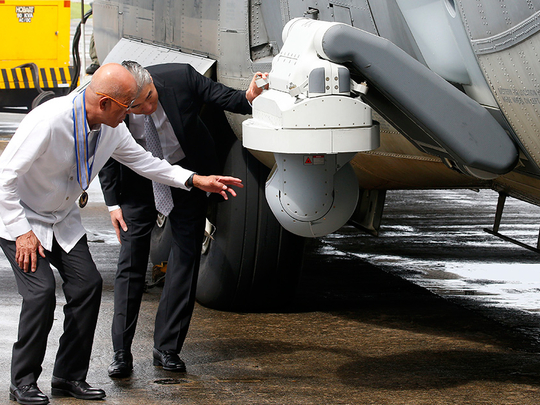
Manila: The United States has handed over sophisticated, aircraft-borne electronic equipment to the Philippines, which will allow its armed forces to monitor the country’s maritime domain from as far as 200 kilometres away.
Called the Special Airborne Mission Installation and Response (SABIR), the system has been mounted on the side of one of the Philippine Air Force’s C-130 cargo aircraft.
“The system will increase the Philippine military’s maritime domain awareness, airborne command and control, counterterrorism, and humanitarian assistance and disaster relief (HADR) capabilities,” a statement issued by the US Embassy said during the turnover of the new equipment to by US Ambassador Sung Kim to Secretary of National Defence Delfin Lorenzana at the Villamor Air Base in Pasay City last August 14.
The Philippines, an archipelago, has one of the world’s biggest coastlines and often, its forces are hard pressed in monitoring the country’s maritime expanse given the country’s limited resources.
The US embassy said the SABIR was given to the Philippine Air Force (PAF) through Maritime Security Initiative (MSI) funding, a US initiative to build the maritime capacity of Southeast Asian nations.
“The total value of the transfer is PhP807 million ($15.1 million), which includes the cost of training, installation, and sustainment support in addition to the equipment itself,” the embassy said.
The SABIR system is a bolt-on avionics module for the C-130 Hercules aircraft. The system upgrades the aircraft with advanced command and control, communications, computer, and surveillance and reconnaissance capabilities without sacrificing the aircraft’s primary function as a cargo plane.
The SABIR system is part of the 300 AISW platform, also provided by the US, which integrates the various systems recently provided by the US military to the Philippines to a common data interface. This includes the unmanned aerial vehicle “Scan Eagle” and the C-208 airborne surveillance aircraft of the Philippine Airforce which are all donated by the US government.
In August 2017, the US turned over a new Tethered Aerostat Radar System (TARS) to the Philippine Navy which will enhance its maritime surveillance capabilities.
The rapidly-deployable 28M Class TARS, which is basically a radar blimp, can rise to an altitude of 1,500 metres while tethered by a single cable. It is a self-sustained, unmanned lighter-than-air platform.
Just like the SABIR, Scan Eagle, the 300 AISW and the C-208, the donation would enhance the Navy’s capability in maritime intelligence surveillance and reconnaissance by detecting maritime and air traffic within the country’s coastal waters.
The United States, as a long-standing friend, partner, and ally of the Philippines, continues to provide support to the Armed Forces of the Philippines (AFP) through both grant assistance and expedited sales of arms and munitions to assist the AFP modernisation goals and urgent counterterrorism and Humanitarian and Disaster Response (HADR) requirements









